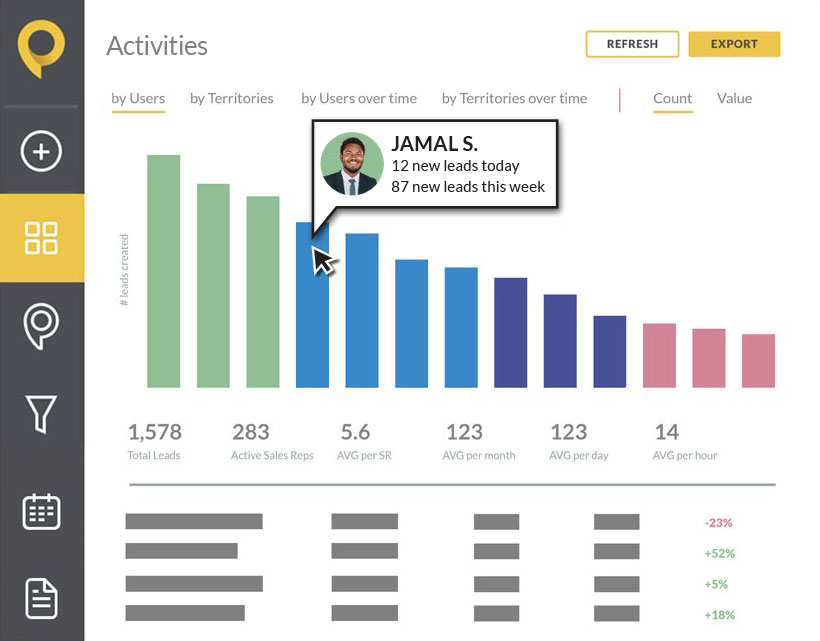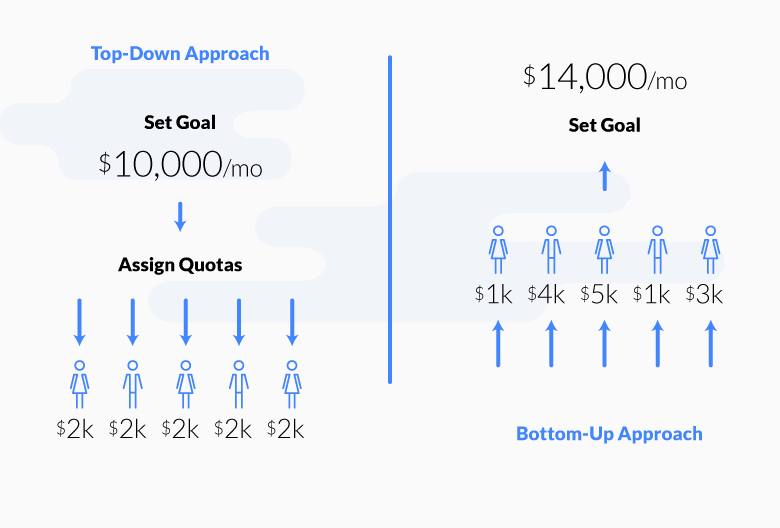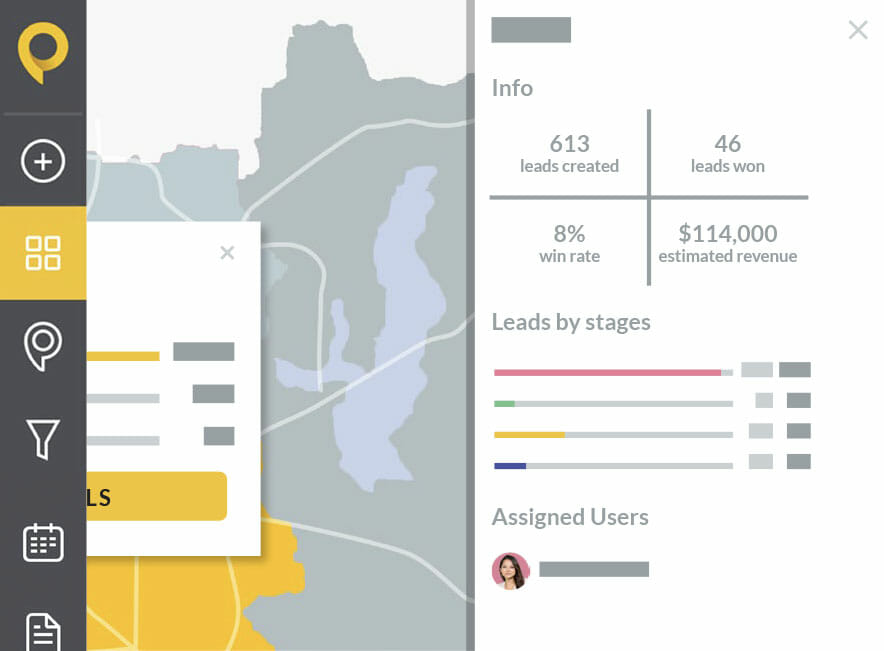Data is the world’s most valuable commodity.
It drives transformations like nothing else, providing useful insights, critical guidance, and powerful perspectives. Within your company, there are few people that rely more on data than your sales professionals.
Sales performance metrics have never been more accessible. We have countless tools in our environment, all churning out more information than we can handle. But sales managers may not know which data is most important for tracking sales performance — and they may not have time to figure it out.
We can help you with that.
In this article, we’ll look at which sales performance metrics are the most valuable for your team, and how they can help you spot everything from bottlenecks to new opportunities.
What Are Sales Performance Metrics?
Sales performance metrics are measurements of the activities that happen in a business. They are statistics tracked over time that can be quantified into useful figures that company leaders can use as guidance and benchmarks for growth.
With the right sales performance measurement strategies, you can figure out where you’re getting the most return on your investment from your sales team, and where you’re missing out on crucial chances to earn.
Long-term analysis of sales data can improve your sales performance, increase customer satisfaction, and boost team efficiency.
Why Measure Sales Performance Metrics?
As helpful as the right sales metrics can be, tracking down the best data for your team isn’t easy. However, this process is worth the effort.
Sales productivity metrics help you evaluate performance in various areas so that you can make decisions about your future based on real, authentic knowledge.
For instance, if you notice that your revenue is dropping from one month to the next, you can use your sales performance metrics to find out why that is.
Monitoring sales analytics with the correct metrics:
- Increases performance by showing you the bottlenecks in your sales processes
- Optimizes sales activities by indicating which strategies work best
- Reveals new opportunities by highlighting under-served areas
- Improves accountability so that you can stay compliant in your industry
- Helps you to create training strategies that enhance sales productivity
- Increases the satisfaction of both employees and customers alike
Let’s take a look at the kind of sales performance measurement options you need to consider.
13 Critical Sales Performance Metrics to Track in 2022
The metrics you choose to measure when you’re assessing team performance might not be the same as the analytics your competitors are monitoring.
You may even find metrics beyond the 13 mentioned here that are valuable to your brand. However, we’ve found that most leading companies end up assessing these metrics at one time or another:
| Top Sales Performance Metrics 1. Number of new leads 2. Number of new opportunities 3. Lead-to-opportunity conversion rate 4. Number of completed quotes or demos 5. Number of closed deals 6. Quote-to-close ratio 7. Sales quota attainment 8. Total revenue 9. Revenue by territory 10. Average deal size 11. Expansion revenue 12. Average sales cycle 13. Sales activity completion rates |
1. Number of Leads Contacted
There are two ways that you can collect leads for your business. The first option is to wait for your audience to come to you, responding to your marketing strategies and organic promotion.
The second option is to reach out to potential customers through calls, emails, and other forms of contact. If you’re using outbound marketing to ramp up your sales, then you’ll need to keep track of the number of leads you’re actually contacting.
This KPI tells you exactly how active your sales reps are. What’s more, it can also show you if there’s something wrong with your funnel. You might decide that increasing your reach rate is essential for your organization’s growth, and therefore invest in a CRM tool that comes with a built-in predictive dialer to help you reach more people.
2. Number of Opportunities Created
Contacting a lead doesn’t necessarily mean that you’ll create an opportunity every time.
Some of the people your sales reps connect with simply won’t want to invest in your service or products. You can’t win every time.
However, keeping track of the number of opportunities you create is essential to determining whether you’re investing in the right strategies for lead acquisition.
If the ratio of calls made to opportunities created is too low, then you might need to start approaching your customers in a different way.
Perhaps your marketing message needs to be different, or you need to update your buyer personas to ensure that you’re connecting with the right people.
3. Lead to Opportunity Conversion Rate
Another commonly used measurement rate is the “lead-to-opportunity” conversion rate — the number of new leads that your reps convert into sales-qualified opportunities.
Your sales management plan should help you turn as many opportunities into paying customers as possible. If it doesn’t, then you need to figure out what’s going wrong.
Perhaps your offer to potential clients just isn’t as attractive as you originally thought.
Maybe you need to dive deeper into your customer research to find out what your audience really needs from you.
4. Number of Quotes or Demos Delivered
You’ve probably noticed that most SaaS companies don’t push their customers to go straight into a paid subscription.
Not every client goes straight from opportunity to customer — many of them will want to try out your product first or take some time to consider your proposal.

Tracking the number of completed quotes or demos will help you to see how many warm leads your company is developing.
In other words, if someone asks for a quote or a demo, then they’re already interested in your brand. If you see a sudden drop in leads after the quotes go out, there may be something wrong with your pricing, or the way your reps explain it. If your demos aren’t driving purchases, perhaps you’re not showing off your best features?
5. Number of Deals Closed
This is often the most valuable sales performance measurement for most companies. Your conversion rate — or “win rate” — highlights how many of your leads ultimately become customers.
If you get around 500 leads per month, and about 50 of them actually buy from you, then you have a conversion rate of 10%.
Using this metric will help you to calculate exactly how many leads you need to reach your revenue targets.
For instance, if your monthly quota is $800,000, and your average deal size is $1,000, then you know that your team needs to close at least 800 leads for you to reach your target.
You can also use your win rates over time to see whether your reps are becoming more effective, or if you might be losing opportunities based on a change in your strategy.
It’s worth keeping in mind that sometimes your win rate will drop when your business grows. Shifting from SMB to mid-market, or mid-market to enterprise can be a big step, and it often reduces close rates slightly.
Fortunately, with the right tools, like SPOTIO, you can make sure that your managing leads and tracking sales activities carefully, so that you don’t miss out on any opportunity to continue growing.

6. Quote-to-Close Ratio
Your quote-to-close ratio is the number of quotes that have resulted in a sale. So, if your reps provide 20 quotes in a month resulting in 10 sales, your quote-to-close ratio is 50%.
The ideal quote-to-close ratio varies by business sector. Research industry averages to define a baseline for this metric.
7. Sales Quota Attainment
We mentioned above that looking at your conversion rates can give you an insight into how many deals you need to close to reach your targets.

(Source)
Sales quota attainment shows you whether you’re actually coming close to those targets. Tracking this metric will give you an insight into how well your team is performing.
However, when you compare it with other metrics, like lead-to-opportunity rate and number of leads contacted, it can also help you to determine whether you’re being unrealistic with your goals.
Perhaps you need to hire more staff if you want to get anywhere close to the number that you were predicting. Or maybe your sales team just needs some better tools to help them reach their goals.
Either way, your sales quota attainment metric will help you to figure it out.
8. Total Revenue
Total revenue tells you how much money you receive during a specific timeframe. Revenue is offset by discounts, returned merchandise and products, and more. It’s a bit of a nuanced metric.
If your business is subscription-based, you can track revenue on a monthly recurring basis. You can also look at annual recurring revenue.
Ideally, you’ll want to be creating a plan that helps you increase your total revenue incrementally each month.
9. Revenue by Territory
While looking at your overall revenue is valuable, it often helps to dive a little deeper into the numbers. You can view your revenue by categories like percentages of renewing customers, or percentage of new business.
You can also see which territories are getting the most sales, if you’re spread across different areas.

| Bonus resources: |
10. Average Deal Size
The longer you run your company, the easier it will be to predict how much you can expect to make from each interaction with a customer.
Average deal size is one of the most overlooked metrics to measure sales performance – but it can be extremely valuable. You calculate this figure by dividing your total number of deals by the total value of those deals.
(Source)
Looking at this metric on a quarterly or monthly basis can tell you if your average deal size is consistent, growing, or shrinking.
If you’re trying to grow your company, average deal size can determine if you’re moving in the right direction. This metric can also help you spot potentially risky deals that are out of scope, or too small to deserve your attention.
11. Expansion Revenue
Expansion revenue is sometimes referred to as expansion MRR or monthly recurring revenue. This metric measures the amount of additional revenue that’s coming from existing customers in your network.
Since it can cost up to five times more to acquire a new customer than maintain an existing one, this is a pretty important number to track.
To calculate your expansion MRR for a given month, add all the additional revenue from upsells and cross-sells from current customers that occurred in that month.
Most companies will calculate their expansion revenue as a percentage rate so that it’s easier to compare it to their previous months. This metric can be a great insight into how satisfied your existing customers are.
12. Average Sales Cycle
Finally, the average length of your sales cycle is always worth looking at.
(Source)
You might find that some reps are closing a deal in three weeks, while others are closing in 10 weeks. You may also learn that the reps that take longer to close end up with happier, more valuable customers.
The key to success here is figuring out which sales cycle length produces the most valuable closed deals for your company.
Once you know that, you can begin adding specific processes to your sales cycle that help drive revenue and opportunities.
13. Sales Activity Completion Rates
To hit your sales goals, everyone on the team needs to be completing their routine tasks — making calls, following up with leads, and adding notes from sales meetings. If you use sales productivity software, sales reps can accurately track these activities, even when they’re in the field. And that means sales managers can see activity completion rates in real time.
Monitor Performance Metrics with a Sales Dashboard
There are a lot of numbers that can help sales managers evaluate productivity — as long as they have the right tools. That’s why it’s always a good idea to have software that turns complex analytics into useful information. SPOTIO’s “My Reports” feature gives you instant access to key performance metrics and lets you generate reports in seconds.
SPOTIO has useful tools for tracking sales performance both historically and in real time. What’s more, it can show you precisely where you need to invest more time into your growth.
Let SPOTIO help you make sense of the data. See how our sales tracking software can bring new transparency to your processes.
________
SPOTIO is the #1 field sales engagement and performance management software that will increase revenue, maximize profitability, and boost sales productivity.
Want to see a product demonstration? Click here to see how SPOTIO can take your sales game to the next level.






